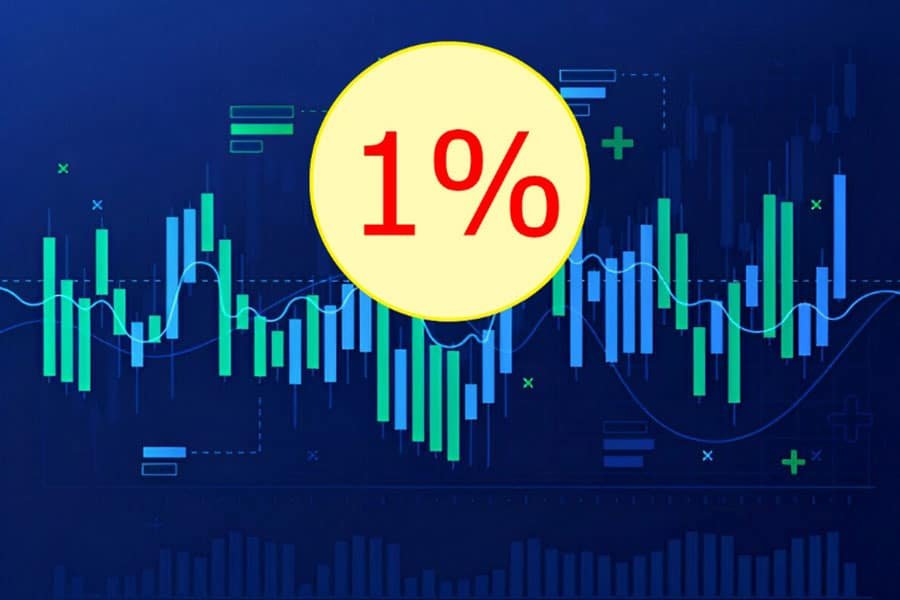The 1% Risk Rule is one of the most fundamental and widely recommended money management strategies in trading. It’s a principle that helps traders control their losses, protect their capital, and survive long enough in the markets to become consistently profitable. Whether you’re a beginner or an experienced trader, understanding and applying the 1% Risk Rule can significantly improve your risk management and trading discipline.
Understanding the 1% Risk Rule
At its core, the 1% Risk Rule means that you should never risk more than 1% of your total trading capital on a single trade.
For example: If you have a trading account of ₹1,00,000, then according to the 1% rule, the maximum you should risk on any one trade is ₹1,000. This doesn’t mean your position size is ₹1,000 — it means the potential loss if the trade goes against you should not exceed ₹1,000.
Why the 1% Rule is So Important
✅ Capital Preservation
Trading is all about staying in the game. If you risk too much on a single trade and it goes wrong, you could blow up your account quickly. The 1% rule ensures that even a series of losses won’t wipe you out.
✅ Emotional Stability
When you know your losses are limited, it reduces emotional stress. This helps you make more rational and less impulsive trading decisions.
✅ Surviving Losing Streaks
Even the best traders face losing streaks. If you lose 10 trades in a row while risking 1% per trade, you’ve only lost 10% of your account — still manageable. But if you were risking 5-10% per trade, you’d be down 50-100%, which is a disaster.
How to Apply the 1% Rule in Real Trades
Here’s a step-by-step guide on how to use the 1% rule:
1. Know Your Account Size
Let’s assume your trading capital is ₹50,000.
2. Calculate 1% of Your Capital
1% of ₹50,000 = ₹500
This is the maximum amount you are willing to lose on a single trade.
3. Determine Your Stop-Loss Level
Decide where you’ll place your stop-loss in terms of price.
For example, if you’re buying a stock at ₹100 and your stop-loss is ₹98, your risk per share is ₹2.
4. Calculate Your Position Size
Now use this formula:
Position Size = Amount to Risk / Risk per Share
So: ₹500 / ₹2 = 250 shares
This means you can buy 250 shares with a ₹2 stop-loss to stay within your 1% risk limit.
Adjusting the Rule Based on Experience
While the 1% rule is a great place to start, some traders adjust their risk levels based on their experience and confidence:
- Beginner traders: Should stick to 0.5%–1% per trade
- Intermediate traders: Might risk 1%–2% per trade
- Advanced traders: Some go up to 3%, but very carefully
Never risk more than you can afford to lose — no matter how good the setup looks.
1% Risk vs. Position Size: Don’t Confuse Them
Many new traders confuse “1% risk” with “1% of their capital used in a trade.” But they are not the same.
- If you buy ₹1,000 worth of shares from a ₹1,00,000 account, you’re using 1% of your capital — but your risk depends on your stop-loss.
- The 1% Risk Rule refers to the amount of capital you’re willing to lose, not the total amount invested.
Benefits of the 1% Rule
- Encourages long-term thinking
- Keeps losses small and manageable
- Builds emotional discipline
- Helps avoid account blow-ups
- Allows you to learn from trades without heavy financial damage
Limitations of the 1% Rule
While this rule is great for protecting your capital, it may not suit every trading style:
- Scalpers or high-frequency traders may use smaller percentages due to the frequency of trades.
- Traders with very small accounts may find it difficult to implement strictly.
- In volatile markets, stop-losses might be wider, reducing position sizes too much.
Still, these can be adjusted with time and experience.
Combining 1% Rule with Risk-Reward Ratios
Using the 1% rule alongside a good risk-to-reward ratio (like 1:2 or 1:3) boosts your profitability. For example:
- Risking ₹500 to potentially gain ₹1,000 (1:2 ratio)
- Even with only 40% win rate, you can still be profitable
Conclusion
The 1% Risk Rule is one of the simplest yet most powerful money management techniques in trading. It teaches you to control losses, remain disciplined, and trade like a professional. Remember, trading is not about hitting home runs — it’s about consistency, control, and capital preservation. By risking only 1% per trade, you give yourself the best chance to stay in the game, survive the learning curve, and build wealth over time.
